Intel's Vision Of Tomorrow, Today
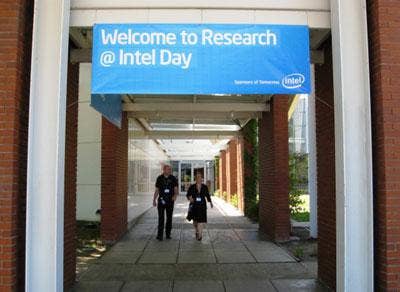
Intel hosted its annual Research@Intel Day last Thursday in Mountain View, Calif., where the chip giant's researchers demoed the possible technology innovations of tomorrow at the Computer History Museum. Here's a quick look at the futurescape Intel laid out at its big R&D-palooza. (Hint: The world of tomorrow has lots of Intel processors.)
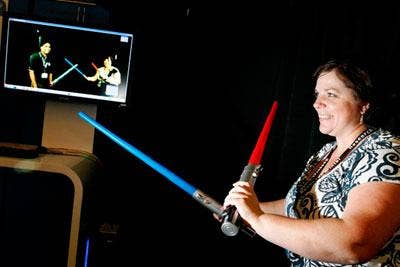
A Research@Intel Day attendee participates in a 3-D virtual light saber duel, or Tele-Immersive Saber Fencing, as the presenters from the University of Illinois at Urbana-Champaign call it. Intel and Microsoft founded the Universal Parallel Computing Research Center (UPCRC) at the university just last year, and it's already delivering some satisfyingly geeky applications.
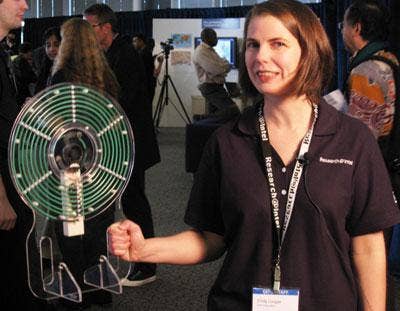
Intel researcher Emily Cooper holds up an audio speaker that's powered wirelessly, independent of orientation, distance and load over a wide range of operating conditions. This demonstration of wireless power transfer was a huge hit at Research@Intel Day.
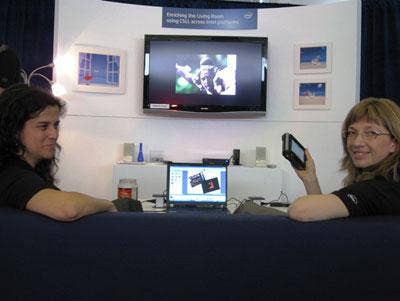
Intel researchers Daria Loi, left, and Barbara Rosario chillax in their model wireless living room during Research@Intel Day. The entertainment center expands Intel's Carry Small, Live Large vision, tying a set-top box that streams HDTV, the Internet, video games and other media to a smartphone or mobile Internet device (MID) that serves as a remote control. Users can manipulate their handset controller through the keypad or via voice commands, or even use gestures to do things such as change the TV channel. Sort of like Wii Fit, but with Law & Order reruns.
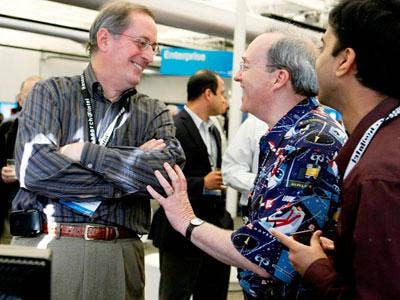
Intel CEO Paul Otellini, left, discusses the day's demonstrations with Research@Intel Day host Justin Rattner, Intel's chief technology officer, center. This year's event showcased more than 45 research projects demonstrating the latest in technology innovation in the areas of ecotechnology, enterprise IT, graphics and mobility.
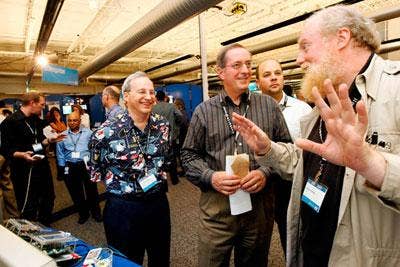
An Intel researcher, right, pitches his project to Intel CEO Paul Otellini, center, and CTO Justin Rattner at Research@Intel Day. Major research efforts on display Thursday included platform power management, WiMAX optimization, Internet security and a project to build out the Internet's infrastructure with general-purpose computers rather than specialized equipment.
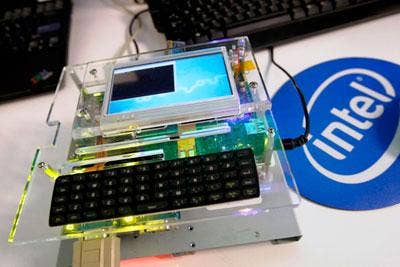
A future mobile Internet device (MID) on display at Research@Intel Day is an example of platform power management, a research effort that Intel hopes will enable up to a 50x reduction in platform idle power for future Intel-based MIDs and smartphones.
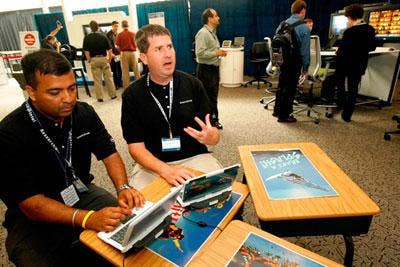
Intel researchers Mayank Sharma, left, and Trevor Pering punch up demonstrations on their Intel Classmate netbook PCs in the Mobility Zone at Research@Intel Day. Part of Intel's Carry Small, Live Large initiative is to provide students with the ability to collaborate in the classroom with applications such as one Intel is developing for displaying content from a mobile device on a larger communal display via wireless transfer.
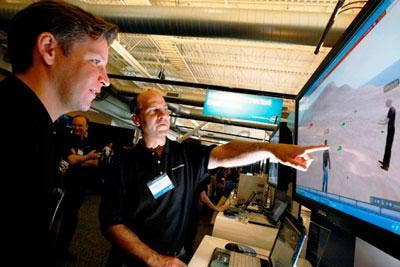
Intel researcher Mic Bowman shows an attendee ScienceSim, Intel's prototype of a 3-D Internet platform for scientific researchers. Bowman confesses that most people seeing ScienceSim for the first time assume it's geared toward video gaming, but in reality Intel is hoping to build a common place where scientists can create visual simulations online and collaborate more effectively together. Over a rousing game of Grand Theft Auto IV. Just kidding. Sort of.
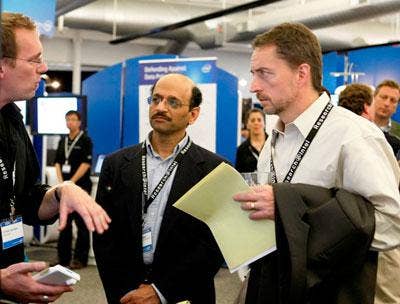
An Intel researcher, left, explains the nuts and bolts of his project to Pat Gelsinger, general manager of Intel's Digital Enterprise Group, right, and another Intel colleague. How many of these research projects develop into commercially viable product offerings? Not many, admits one Intel product manager, and even those that do may gestate for years before the market and the high-tech ecosystem are ready for their arrival.
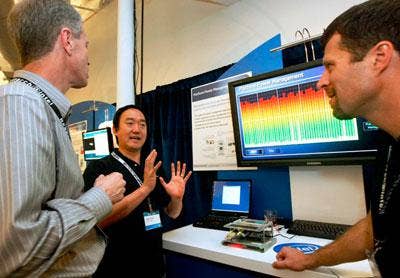
Paul Diefenbaug, left, Intel principal engineer, and another Research@Intel Day attendee, right, listen to researcher James Song describe his team's efforts in platform power management, a project that Intel believes will enable up to a 50x reduction in platform idle power for future Intel mobile Internet devices (MIDs) and smartphones.
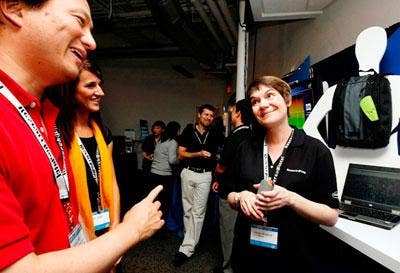
Allison Woodruff, right, an Intel researcher, talks to Andrew Chien, an Intel Labs vice president, about how individuals and communities will be able to help the environment with her team's new personal mobile device prototype that senses and collects air quality data.
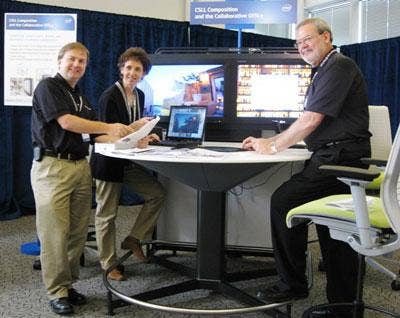
Mary Murphy-Hoye, center, an Intel senior principal engineer, and her colleagues gather around a collaborative office prototype technology at Research@Intel Day. Another example of Intel's Carry Small, Live Large vision in action, this office conferencing station connects participants' various computing devices, such as laptops and mobile Internet devices (MIDs), to a larger display for presentations and collaborative work. A device simply has to be brought into range of the Intel Atom-powered wireless exchange and a simple touch-screen interface is used to connect to the collaborative display.
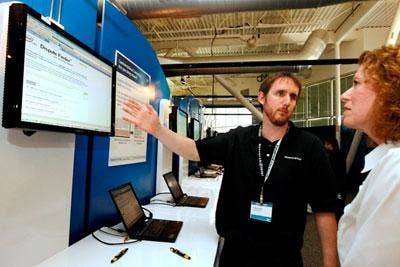
Intel may be a hardware company, but its researchers develop plenty of interesting software as well. Here, researcher Rob Ennals, left, shows a Research@Intel Day attendee a project called Dispute Finder, a beta Web site where users can submit factual information they find online and learn whether they've been duped.
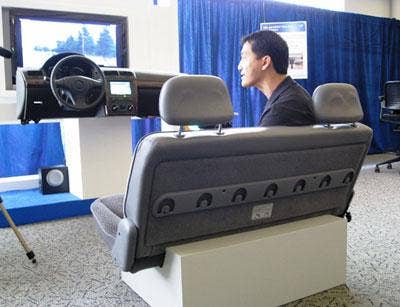
Intel is pretty much committed to pushing WiMAX into every environment imaginable, and the open road is no exception. Here, an Intel researcher revs up a simulation of an Atom-powered, WiMAX-enabled car that delivers personalized, enhanced in-vehicle entertainment.